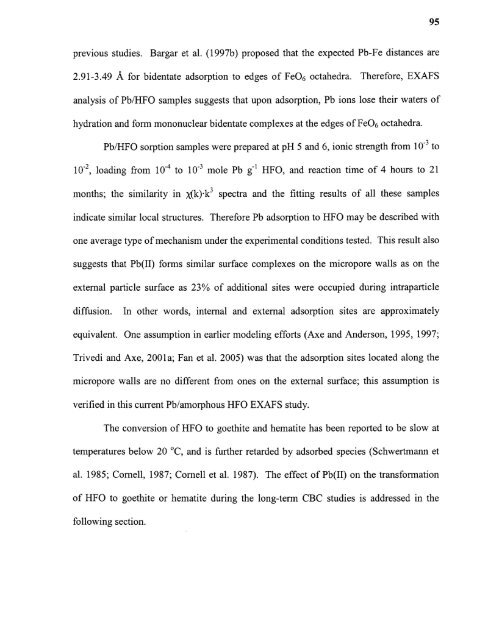Heavy metal adsorption on iron oxide and iron oxide-coated silica ...
Heavy metal adsorption on iron oxide and iron oxide-coated silica ...
Heavy metal adsorption on iron oxide and iron oxide-coated silica ...
Create successful ePaper yourself
Turn your PDF publications into a flip-book with our unique Google optimized e-Paper software.
95previous studies. Bargar et al. (1997b) proposed that the expected Pb-Fe distances are2.91-3.49 A for bidentate <str<strong>on</strong>g>adsorpti<strong>on</strong></str<strong>on</strong>g> to edges of FeO6 octahedra. Therefore, EXAFSanalysis of Pb/HFO samples suggests that up<strong>on</strong> <str<strong>on</strong>g>adsorpti<strong>on</strong></str<strong>on</strong>g>, Pb i<strong>on</strong>s lose their waters ofhydrati<strong>on</strong> <strong>and</strong> form m<strong>on</strong><strong>on</strong>uclear bidentate complexes at the edges of FeO6 octahedra.Pb/HFO sorpti<strong>on</strong> samples were prepared at pH 5 <strong>and</strong> 6, i<strong>on</strong>ic strength from 10 -3 to10 -2, loading from 104 to 10-3 mole Pb g-1 HFO, <strong>and</strong> reacti<strong>on</strong> time of 4 hours to 21m<strong>on</strong>ths; the similarity in x(k)-k3 spectra <strong>and</strong> the fitting results of all these samplesindicate similar local structures. Therefore Pb <str<strong>on</strong>g>adsorpti<strong>on</strong></str<strong>on</strong>g> to HFO may be described with<strong>on</strong>e average type of mechanism under the experimental c<strong>on</strong>diti<strong>on</strong>s tested. This result alsosuggests that Pb(II) forms similar surface complexes <strong>on</strong> the micropore walls as <strong>on</strong> theexternal particle surface as 23% of additi<strong>on</strong>al sites were occupied during intraparticlediffusi<strong>on</strong>. In other words, internal <strong>and</strong> external <str<strong>on</strong>g>adsorpti<strong>on</strong></str<strong>on</strong>g> sites are approximatelyequivalent. One assumpti<strong>on</strong> in earlier modeling efforts (Axe <strong>and</strong> Anders<strong>on</strong>, 1995, 1997;Trivedi <strong>and</strong> Axe, 2001a; Fan et al. 2005) was that the <str<strong>on</strong>g>adsorpti<strong>on</strong></str<strong>on</strong>g> sites located al<strong>on</strong>g themicropore walls are no different from <strong>on</strong>es <strong>on</strong> the external surface; this assumpti<strong>on</strong> isverified in this current Pb/amorphous HFO EXAFS study.The c<strong>on</strong>versi<strong>on</strong> of HFO to goethite <strong>and</strong> hematite has been reported to be slow attemperatures below 20 °C, <strong>and</strong> is further retarded by adsorbed species (Schwertmann etal. 1985; Cornell, 1987; Cornell et al. 1987). The effect of Pb(II) <strong>on</strong> the transformati<strong>on</strong>of HFO to goethite or hematite during the l<strong>on</strong>g-term CBC studies is addressed in thefollowing secti<strong>on</strong>.
















